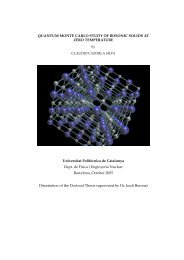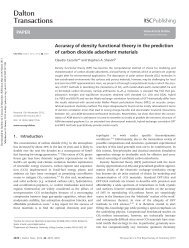Journal of Low Temperature Physics 171, 619 - DR. CLAUDIO ...
Journal of Low Temperature Physics 171, 619 - DR. CLAUDIO ...
Journal of Low Temperature Physics 171, 619 - DR. CLAUDIO ...
You also want an ePaper? Increase the reach of your titles
YUMPU automatically turns print PDFs into web optimized ePapers that Google loves.
J<strong>Low</strong>TempPhys<br />
i.e., we used the product <strong>of</strong> a liquid-like wave function by a Gaussian term whose<br />
purpose is to confine the H 2 molecules around the crystallographic positions (x I ,y I )<br />
corresponding to the particular solids we are interested in. The parameters b and<br />
c on Eq. (1) and Eq. (2) were optimized using previous Variational Monte Carlo<br />
calculations on each <strong>of</strong> the phases considered.<br />
The H 2 –H 2 interactions were modeled by the Silvera and Goldman potential [4]<br />
and the H 2 –C and H 2 –H by a Lennard-Jone one. In this last case, we used the<br />
Lorentz-Berthelot combination rules to obtain the mixed parameters from the C–C<br />
and H–H interactions given in Ref. [5] and from the H 2 –H 2 ones in Ref. [6].<br />
3 Results<br />
A summary <strong>of</strong> our simulation results on C-graphane is displayed in Fig. 1. From there,<br />
we can see that the ground state for H 2 on this structure is a √ 3 × √ 3 commensurate<br />
solid (solid circles in Fig. 1), since its energy per particle is lower than that <strong>of</strong> any<br />
other arrangement. This structure is similar to the ground state <strong>of</strong> H 2 on graphene [7].<br />
When the H 2 density increases, we observe a phase transition (see Table 2)toaδ commensurate<br />
phase (similar to the one obtained for D 2 on graphene [8, 9]) that changes<br />
to a triangular incommensurate solid (see Table 2) upon further hydrogen intake. The<br />
stability limits for these arrangements were determined by means <strong>of</strong> Maxwell doubletangent<br />
constructions. In this figure we also display the data for other structures: a 2/5<br />
commensurate phase, a 3/7 commensurate arrangement and third structure found stable<br />
on B-graphane (see below). Any <strong>of</strong> those structures are metastable with respect<br />
to a mixture <strong>of</strong> the √ 3 × √ 3 phase and the δ phase (in the case <strong>of</strong> the 2/5 structure)<br />
or the incommensurate solid (for the 3/7 phase and the commensurate one), due to<br />
their relatively high energies per particle .<br />
Fig. 1 Energy per particle for<br />
different H 2 phases adsorbed on<br />
C-graphane. Solid circle,<br />
√<br />
3 ×<br />
√<br />
3 registered solid; solid<br />
square, δ phase; inverted solid<br />
triangles, liquid arrangement;<br />
and circles, incommensurate<br />
triangular solid. Solid triangle,<br />
commensurate structure; square,<br />
3/7 phase; solid diamond, 2/5<br />
phase. The dashed and the solid<br />
line are fourth order polynomial<br />
fits to their corresponding data<br />
sets. The statistical error bars<br />
due to the uncertainties in the<br />
DMC calculation are smaller<br />
than the symbols are were not<br />
displayed for simplicity (Color<br />
figure online)





